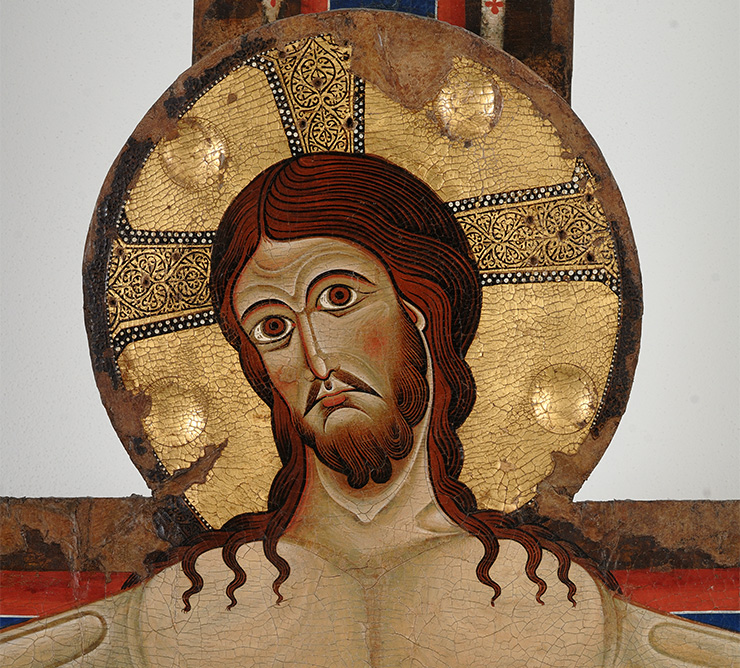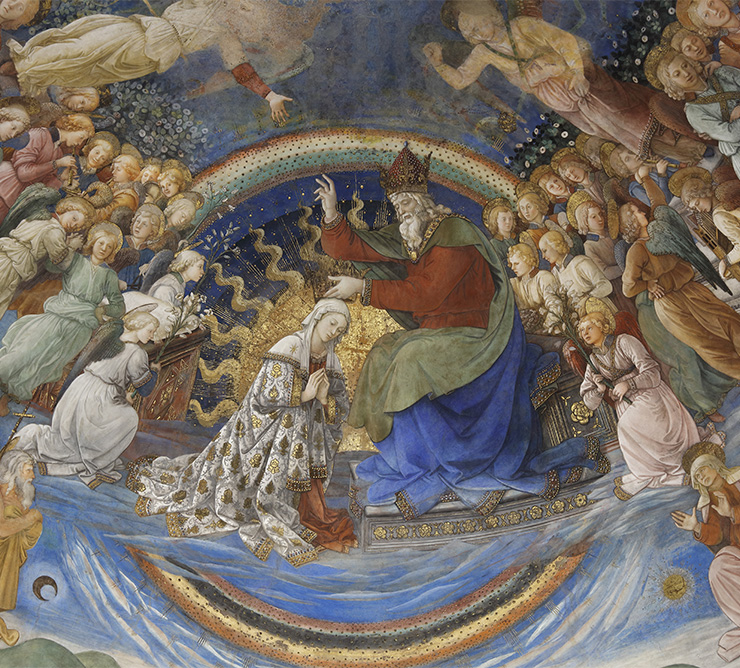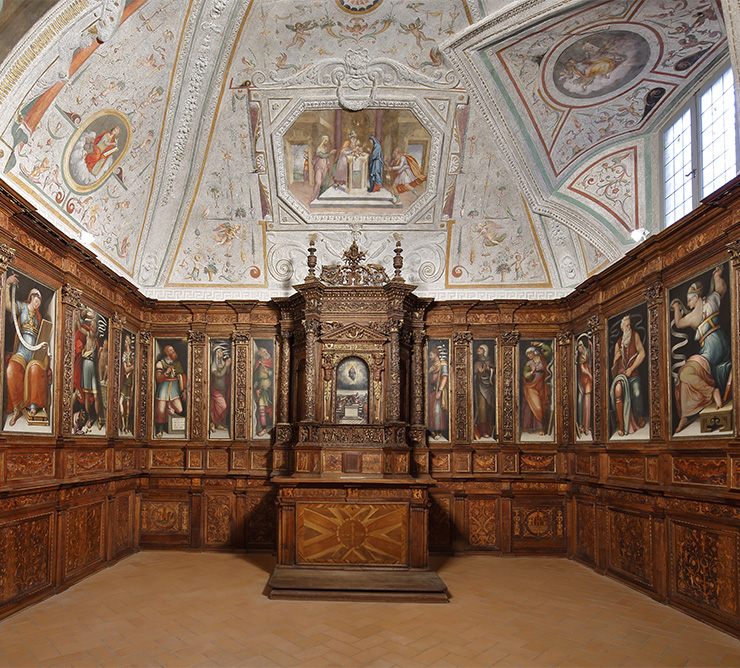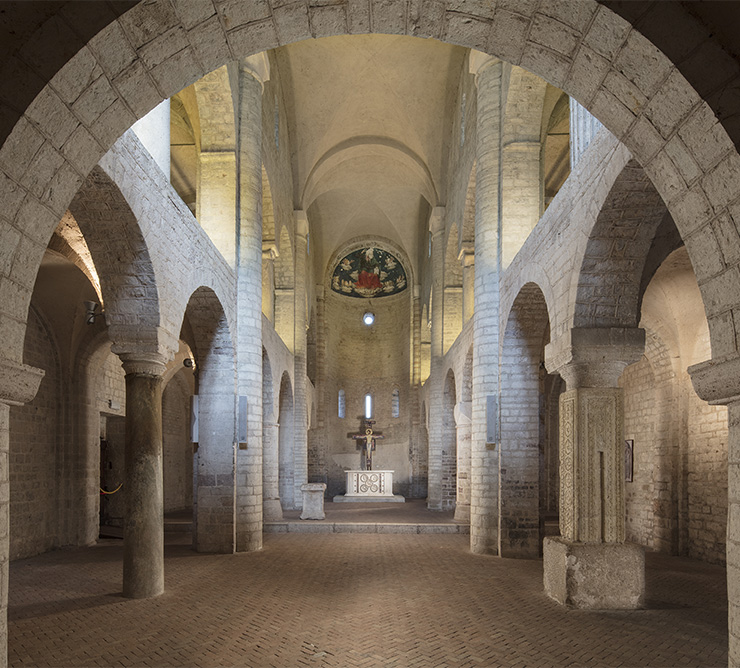Un percorso pensato per ammirare da punti di vista insoliti gli affreschi dell’abside della Cattedrale, la romanica Basilica di Sant’Eufemia e il Museo Diocesano, con l’occasione unica di poter salire sull’antico Campanile ancora funzionante e ammirare la città dall’alto. L’itinerario di visita si diparte dal fianco destro della Cattedrale, la Cappella degli Eroli, Vescovi di Spoleto, dedicata all’Assunta e con affreschi di Jacopo Siculo raffiguranti Profeti e scene del Vecchio e Nuovo Testamento.
L'esperienza è attiva dal 26 marzo al 1° novembre.
Sarai idealmente accolto dalla Madonna Assunta venerata dal Vescovo Eroli e alla quale è dedicata la Cattedrale. La visita conduce agli affreschi di Filippo Lippi nell'abside, sempre sulla tematica dell'Assunta, culmine del percorso estetico e religi... more
Sarai idealmente accolto dalla Madonna Assunta venerata dal Vescovo Eroli e alla quale è dedicata la Cattedrale. La visita conduce agli affreschi di Filippo Lippi nell'abside, sempre sulla tematica dell'Assunta, culmine del percorso estetico e religioso. La chiesa custodisce, inoltre, vari capolavori: dalla facciata al pavimento percorrendo stili e scuole, dall’arte delle origini al Romanico, dal Rinascimento al Barocco fino al Neoclassicismo. Ma il Duomo non conserva soltanto monumenti, è anche luogo per eccellenza della spiritualità, con particolare riguardo alla Cappella delle Reliquie dove è custodita la preziosa lettera autografa di San Francesco d’Assisi a Frate Leone. Troviamo, inoltre, la Cappella della Santissima Icona realizzata nel 1626 al posto della vecchia sagrestia per ospitare la tavoletta bizantina donata alla città da Federico Barbarossa nel 1185 in segno di riconciliazione e nella quale la Vergine Maria tiene in mano un cartiglio, che sebbene non attualmente leggibile poiché l'icona è ricoperta di una riza d'oro, riporta un dialogo commovente tra il Figlio e la Madre:
- Che cosa chiedi, o Maria?
- La salvezza dei viventi.
- Ma provocano a sdegno.
- Compatiscili, Figlio mio.
- Ma non si convertono!
- E tu salvali per grazia.
L'icona è attribuita dalla tradizione a San Luca e con ogni probabilità è pervenuta in Italia durante la controversia iconoclasta in Oriente nel VIII-IX secolo. Alla “Santissima Icona” è collegata, tra l’altro, la conversione del giovane Francesco Possenti (San Gabriele dell’Addolorata).
Oltre alla visita della Cattedrale, sarà possibile proseguire il cammino verso il Museo Diocesano e la Basilica di Sant’Eufemia. Il Museo, situato all’interno del Palazzo della Curia Arcivescovile, conserva opere che vanno dall’arte delle origini al Rinascimento fino al Barocco: maestri spoletini, fiorentini, romani, dall’autore della Croce azzurra al Maestro di San Felice di Giano, da Neri di Bicci a Filippino Lippi, da Domenico Beccafumi al Cavalier d’Arpino fino a Gian Lorenzo Bernini.
lessCATTEDRALE:
da Aprile a Ottobre:
lunedì-sabato 10.30 - 18.00
domeniche e festivi 12.30 - 18.00
Ultimo ingresso al Museo 30 minuti prima dell'orario di chiusura
da Novembre a Marzo:
lunedì-sabato 10.30 - 17.00
domeniche e festivi 12.30 - 17.00
Ultimo ingresso al Museo 30 minuti prima dell'orario di chiusura
MUSEO DIOCESANO E BASILICA DI SANT'EUFEMIA:
da aprile a ottobre:
Tutti i giorni dalle 10:00 alle 13.00 e dalle 14.00 alle 18.00
Ultimo ingresso al Museo 30 minuti prima dell'orario di chiusura
da novembre a marzo:
sabato e domenica dalle 10:00 alle 17:00
Ultimo ingresso al Museo 30 minuti prima dell'orario di chiusura
CHIUSO 25 DICEMBRE 2023 E 1 GENNAIO 2024
In treno:
Collegamenti diretti da Roma via Orte, in 1h20 su 5 treni Eurostar e circa 1h45 su 12 treni regionali. Da Milano, 6h10 su Intercity e 5h15 via Firenze sulla Freccia Rossa. Altri tempi di percorrenza (circa): 4h Bologna, Firenze 3h15, Napoli 3h, Torino 8h30, 6h45 Venezia.
In aereo:
L'aeroporto più vicino è quello di Perugia "San Francesco d'Assisi", con voli giornalieri per Milano Malpensa e con frequenza variabile a Londra e Tirana. I collegamenti per Spoleto sono possibili in taxi e autonoleggio. La migliore alternativa è Roma Fiumicino, con il trasferimento a Spoleto in treno (via Leonardo Express per Roma Termini).
In auto:
Arrivando da sud, Spoleto si trova a 60 km dal casello di Orte della A1: proseguire sulla SS3 Flaminia in direzione Terni e sulla SS395 in direzione Foligno. La distanza da Roma è di circa 150 chilometri. Venendo da nord, è possibile uscire dall'autostrada A1 a Valdichiana e proseguire sulla E45 in direzione di Foligno, poi la SS75 e SS3, per un totale di circa 115 chilometri. La distanza da Milano è di circa 510 km. I veicoli privati non sono ammessi nel centro di Spoleto. Diverse aree di parcheggio sono disponibili nelle vicinanze, con prezzi che vanno da 0,50 € all'ora a 40 € al mese. Informazioni su: Umbria Mobilità Tempi medi di percorrenza: Ancona – Spoleto: 2h 05m - 155 km Firenze – Spoleto: 2h 15m - 210 km Roma – Spoleto: 1h 50m - 145 km Napoli – Spoleto: 3h 22m - 330 km Milano – Spoleto: 5h 05m - 510 km
In bus:
Spoleto è servito da linee di autobus locali, e di altre città in Umbria. Informazioni su: Umbria Mobilità.

Along the right aisle, on the last altar before the transept, is the famous painted Cross by Alberto Sotio dated and signed 1187. It was made for the Spoleto church of Saints John and Paul, where it remained until 1877, when it was transferred to the Cathedral of Santa Maria Assunta. The Cross, painted on parchment applied to the panel, presents Christ in the type of the Triumphans: upright and with his eyes open, as he has symbolically already conquered death. In the side compartments one recognises the two mourners: the Virgin Mary and St. John the Evangelist, while in the suppedaneum the blood runs down from Jesus' feet to Adam's skull at the base of Mount Calvary. In the lower part of the Crucifix we find the date and signature of Sotio.

The Cathedral apse features an extraordinary fresco decoration with Stories from the Life of the Virgin by the Florentine artist Filippo Lippi, who died in Spoleto in October 1469 and is buried inside the Cathedral itself. The Spoleto cycle is his last work: he died before the frescoes were fully completed. On the back wall, in the curve of the apse, divided by painted pilasters, we recognise the Annunciation on the left, the Death of the Virgin in the centre and the Nativity on the right; in the apse basin we find the Coronation of the Virgin in the presence of Angels and Saints. In the Annunciation, Mary, seated inside a portico, turns shyly towards the Angel outside in front of the portico who, kneeling complacently on a floor with marble inlays, holds a lily in his hand; God the Father, supported by clouds and enveloped in rainbow light, sends the Holy Spirit into the Virgin's womb. Recognisable in Mary's likeness is Lucrezia Buti, the woman loved by Filippo and mother of his son Filippino, who from the fifties of the 15th century gave her face to numerous female figures painted by Lippi. The central part depicts the Death of the Virgin Mary: a group of angels and saints attend the funeral of the Virgin Mary lying on her deathbed. In the group we recognise the painter himself, dressed in Carmelite robes, flanked by other figures, perhaps his collaborators, and his young son Filippino Lippi, who began his apprenticeship in Spoleto. On the right, in front of the hut leaning against the ruins of a palace, is the Nativity scene in which the Child Jesus is humbly leaning on the ground. On the right, in the background, the annunciation to the Shepherds is depicted. In the centre of the apsidal basin, on a brilliant blue background and within a disc of light, is the Coronation of the Virgin: the celestial group is surrounded by the angelic hierarchies, as well as the Patriarchs, Prophets, Sibyls and Old Testament heroines.

This chapel houses the autograph letter of St Francis to Brother Leo, a document dated 1224. Originally preserved in the church of San Simone in Spoleto, it is written on a small goatskin parchment. It is one of the two letters written by the saint and recognised by scholars as autograph, and therefore of extremely rare and priceless historical and religious value. Francis is addressing Leo, one of the most assiduous and faithful friars, buried next to him in the basement of the Basilica of Assisi: a tone of moving fraternitas emerges in Francis' words.

The St. Euphemia Church is one of the most remarkable Romanesque buildings in Umbria. Its origins remain uncertain: according to the most accredited hypothesis, it stands on the area that was once occupied by the palatium when Spoleto was under the rule of the Lombards, who elected the city as their ducal seat. The basilica would therefore be the evolution of the palatine chapel of the Lombard dukes dedicated to St Euphemia herself. In the 10th century, a monastery of Benedictine nuns was added to the church; the gallery above the nave of the church is all that remains of the space used by the nuns during the officiating services. The interior, divided into three naves with alternating columns and pillars, seems to recall the Lombard Romanesque style. At the end of the nave, one can admire a beautiful marble altar originally placed in the Cathedral decorated with cosmatesque motifs and featuring five reliefs with symbols of the Evangelists and the Mystic Lamb.